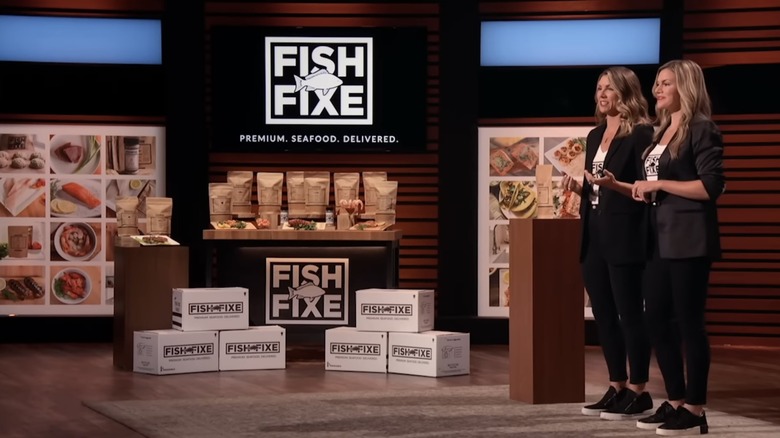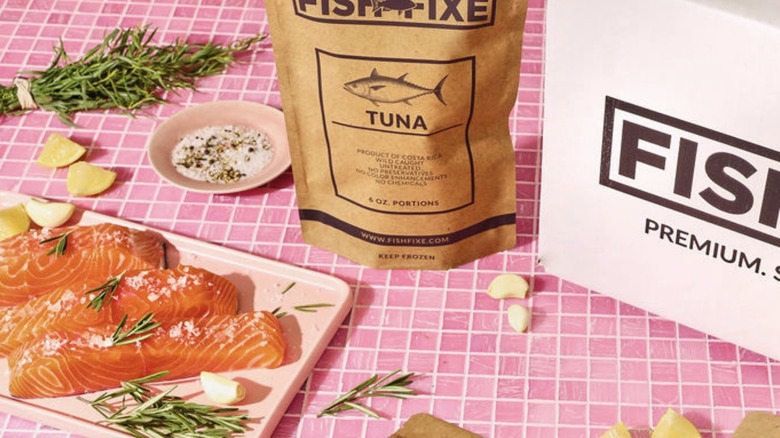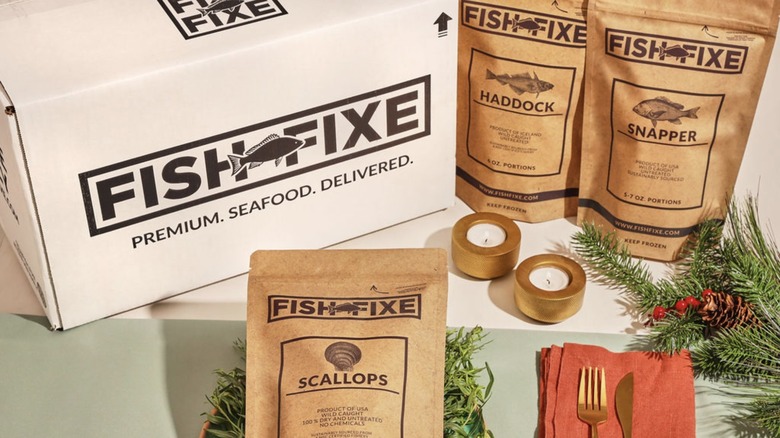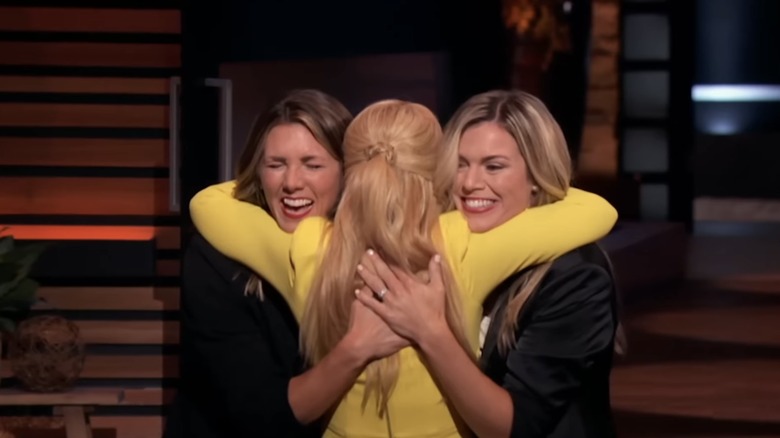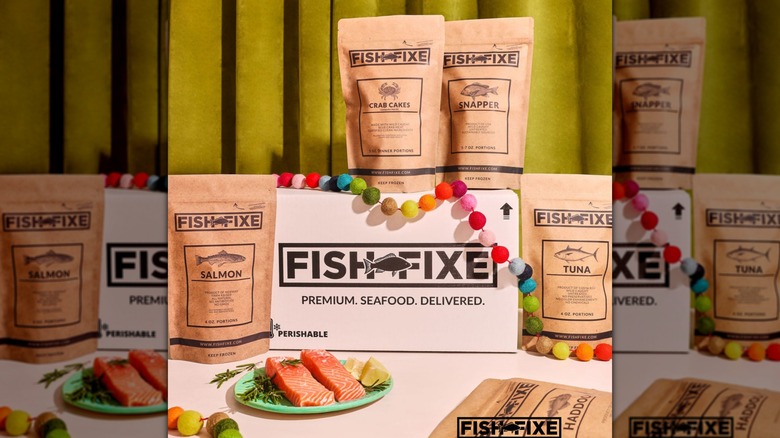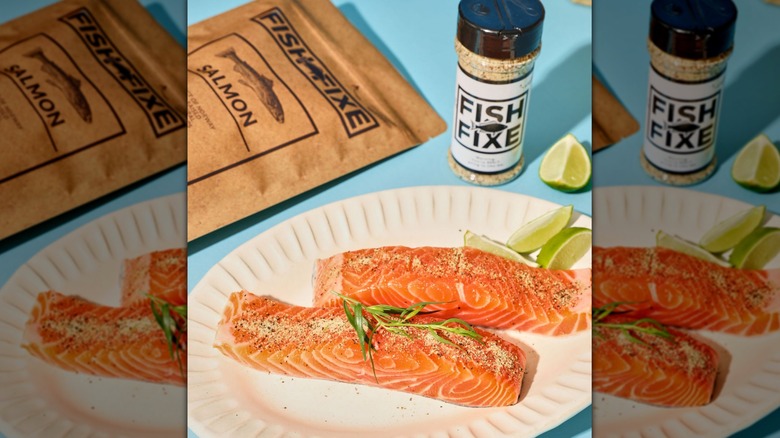Fish Fixe After Shark Tank: We Caught Up With The Founders
Pitching your business on "Shark Tank" is hard enough as it is, but being a food-based company can be even more tricky. But, Emily Castro and Melissa Harrington, the co-founders of Fish Fixe, were prepared, knew what they wanted to get out of a potential deal, and though they were nervous, ended up getting a successful deal in the end. The two business founders were seeking $200,000 for a 15% stake in their company.
The premium seafood straight-to-consumer delivery company received an initial offer from Kevin "Mr. Wonderful" O'Leary at $200,000 for a 33.3% stake in the company, over double the stake in the company the founders initially asked for. After a lot of seafood taste-testing and going through company numbers and metrics, Lori Greiner swooped in front of O'Leary and made Melissa and Emily an offer of $200,000 for a 25% stake in Fish Fixe. Harrington and Castro eagerly accepted the offer. Since the Season 13 episode aired, we got a chance to chat with one of the founders about their experience on Shark Tank, some behind-the-scenes moments you don't get to see, and what the company has been up to since.
Fish Fixe's growth after Shark Tank
Harrington and Castro's families, along with the Fish Fixe team, celebrated the Shark Tank episode in a really special way. "The night of was so fun when it aired," Harrington said. "We had a big party at my house, and all of our friends came. It was so much fun, we had a blast." But the next day after the watch party was when the many phone calls placing orders and asking questions started rolling in.
"We really did have pretty good numbers as far as revenue from the airing," Harrington noted. "And then we fell into our distribution issue, which you saw on the update." If you're a Shark Tank super fan, you'll know that periodically, the show will feature mini updates on companies that have been on previous episodes that got deals with the sharks. Fish Fixe's "Shark Tank" update mentioned that the company had a bad distribution partner right after the initial episode aired, delaying some of the boxes being shipped.
But they were able to solve the problem and find a new distribution solution in a few weeks, and ever since then, the brand is ready for even more business. "I know we're not the only people to go through that, but since then we have our distribution up; it's set and running," Harrington said. "We can handle spikes — every day I'm like lord can we please go viral? We're ready for it."
Harrington applied to Shark Tank in secret
Harrington decided to apply for a spot on "Shark Tank" without telling her co-founder first. The forgiveness, not permission, mindset really worked. "I kind of sneakily behind Emily's back applied for 'Shark Tank'," Harrington explained. "I just went online and did the job form fill out, thinking we got such a long shot. And then we just kept getting that next call from the producers." As a fan of the show, Castro supported the decision and was excited for the company to be on "Shark Tank."
Appearing on the show doesn't happen overnight, however. "It was fun and definitely a lot of work," Harrington recalled. "There's a lot of due diligence that you have to do prior to the show. Like anything, it's going to be as good as the energy and effort and time you put into it." The two prepared a lot for their appearance on the show, figuring out everything from what they were going to wear, writing and re-writing their brand pitch, and memorizing all the company's up-to-date figures.
But preparing to showcase your company on a national television show isn't just about the televised appearance. "So we go on the show right now, how much inventory should we have? What can we expect?" Harrington said. Especially a company like Fish Fixe that ships perishable food items, they had to think about logistics a lot.
What it's like to prep food for a Shark Tank pitch
The Fish Fixe co-founders had to prepare what food they were going to serve on "Shark Tank." They had to decide which seafood products to feature, what recipes to incorporate them into, and then how to keep everything at the correct temperatures for the time they were going to be served to the sharks. "I love to cook," Harrington told us. "Most of all the recipes online are things that I've developed in the kitchen, and I have always loved it."
Luckily, her passion for recipe development and skill for curating the perfect bite came in handy for the pitch. Harrington recalled: "We had to plan out, 'What do we want it to plate like?' 'How many ounces was everything going to be?'" To help with the cooking, plating, and presentation for the show, an on-set culinary expert assisted with the presentation, which Harrington said was extremely helpful. "We did run-throughs at our house; we did time tests," Harrington explained. "And then I sat with the chef and cooked probably 20 to 30 minutes before we went on set."
While the food was prepared, Castro, who doesn't share the same passion for cooking, found another way to keep herself occupied before the nerve-wracking experience. According to Harrington: "She just kept escaping to the waiting room, and she's like 'All I did was put on my lipstick over and over and over.'"
The Fish Fixe team did not expect Greiner's offer
Most of Fish Fixe's "Shark Tank" episode features O'Leary trying to get in on the seafood business with a very high stake in the company compared to the co-founder's initial asking offer. At the tail end of the episode (pun intended), Greiner makes an offer the two business partners couldn't refuse. This was especially surprising to both the co-founders and the audience because, at that point, the investor had said "I'm out" and wasn't making any offers.
Something audiences might not know about the ABC show is that while most business pitches in the shark tank are televised for 10 to 12 minutes, the actual negotiation process in the "Shark Tank" studio can be closer to 40 minutes. The producers and editors just pick the most exciting clips to put together a digestible segment for viewers to watch.
Not featured in the episode was after Greiner took herself out of the running, Harrington and Castro explained more about their business and had a chance to show more of their personalities to the sharks. "I could tell that the more we talked, the more she was engaged," Harrington said. "Lori will say over and over again that she picks people, so I would like to think that's part of why she swings back in."
Partnering with Greiner as a woman-owned business was a dream
One reason the Fix Fixe founders wanted to partner with Greiner — aside from the fact that her offer featured the same amount of money ($200,000) for a lower stake in the company — is that the investor is able to relate to the business owners better. Harrington said, "Lori saved us."
Harrington told us O'Leary's response to how he planned to grow their brand, "He's like, 'Well I would hire my camera crew and then they would film me cooking, and the more he talks about it, like, "Okay, so we're going to hire your people to film you, right?'" Harrington questioned whether his approach would appeal to their target customer. "Who is your audience? Is your audience a bunch of 60-year-old white males? [Fish Fixe] is probably not going to resonate with them."
Once they started talking more about the logistics of how to grow their company, Harrington explained that Greiner's interest got peaked again. After asking a few questions, the investor made her swift offer.
How Fish Fixe differentiates itself from the competition
Since Fish Fixe was founded in 2017, other companies have joined the premium seafood delivery-to-consumer space. But one glance at the brand's website or social media pages will tell you that it approaches the market from a different angle when compared to its competitors.
Because women are the ones with the most purchasing power, Fish Fixe aims to cater to them. According to a consumer study reported by Supermarket News, 78% of women identify as their household's primary shopper, which includes groceries. Harrington says as CEO, and with Castro as Fish Fixe's Creative Director, they intrinsically understand their audience because they are their audience. And with assistance from Greiner, who has an immense amount of experience in cultivating businesses that women love, Fish Fixe offers a lot to its consumers. "We are so different, and I think Lori appreciates that and sees that," Harrington added.
Next steps for Fish Fixe
Since Fish Fixe's initial episode aired, and even since the "Shark Tank" update on the brand, the company has been delivering seafood like the brand's fan-favorite crab cakes, salmon, halibut, and more, in either smaller-packaged quantities or customizable boxes with many types of seafood. "We, from the very beginning, believed that people who sit around and eat around the table and share meals together have healthier relationships and spend more time together," Harrington said.
The brand is looking to expand its seasoning and spice offerings for home cooks. "It helped them kind of diversify their dinner a little bit," Harrington told us. "Like, Cajun seasoning would go great on our white fish. And so, we started playing around with that ... and we're going to have the family of blends that will, you know, just make it even easier for people to cook seafood at home."
Aside from expanding the brand's spice offerings, Harrington said that even further in the future, she could see the brand expanding to high-end seafood protein in a frozen meal kit. "My best friend's parents were just like, 'Can you do it all for me, and then I can just heat it up?'"
